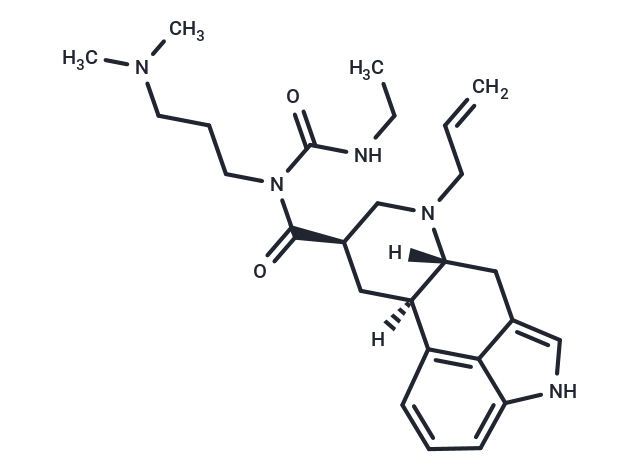Shopping Cart
Remove All Your shopping cart is currently empty
Your shopping cart is currently empty
Cabergoline (FCE-21336) is an ergot derived-dopamine D2-like receptor agonist. It has high affinity for D2, D3, and 5-HT2B receptors (Ki=0.7, 1.5, and 1.2, respectively).Cabergoline permits rapid and effective hormonal and tumor control by normalizing prolactin-producing pituitary adenomas levels.

| Pack Size | Price | USA Warehouse | Global Warehouse | Quantity |
|---|---|---|---|---|
| 1 mg | $34 | In Stock | In Stock | |
| 5 mg | $77 | In Stock | In Stock | |
| 10 mg | $122 | In Stock | In Stock | |
| 25 mg | $243 | In Stock | In Stock | |
| 50 mg | $449 | In Stock | In Stock | |
| 100 mg | $659 | - | In Stock | |
| 1 mL x 10 mM (in DMSO) | $85 | In Stock | In Stock |
| Description | Cabergoline (FCE-21336) is an ergot derived-dopamine D2-like receptor agonist. It has high affinity for D2, D3, and 5-HT2B receptors (Ki=0.7, 1.5, and 1.2, respectively).Cabergoline permits rapid and effective hormonal and tumor control by normalizing prolactin-producing pituitary adenomas levels. |
| In vitro | Cabergoline(10 μM) is used to investigate its neuroprotective effects. MAP2 staining reveals that Cabergoline significantly suppresses the loss of neurons caused by H2O2 incubation. Pretreatment with Cabergoline inhibits H2O2-induced neuronal cell death in a dose-dependent manner. Cabergoline prevents apoptotic cell death following H2O2 exposure [1]. |
| In vivo | Cabergoline demonstrates a longer elimination half-life (63 to 109 hours) compared to other D2-like receptor agonists, offering prolonged clinical benefits from a single dose and potential enhancements in the quality of life for individuals with chronic conditions [1]. It notably reduces the number of rapid eye movement (REM) sleep bouts in female mice, achieving a 67.3% reduction (F(1,11)=12.892, P=0.004) in non-restrained subjects, with the most considerable decrease observed during the dark phase (82.3% reduction). In male mice, Cabergoline significantly lowers baseline Prolactin (PRL) levels by 98.5% (F(1,6)=13.192, P=0.011) to 0.08 ng/mL within two hours post-injection. PRL levels normalize to baseline (5.0±0.60 ng/mL; F(1,6)=0.715, P=0.43) following a seven-day recovery period [2]. |
| Synonyms | FCE-21336 |
| Molecular Weight | 451.6 |
| Formula | C26H37N5O2 |
| Cas No. | 81409-90-7 |
| Smiles | [H][C@@]12Cc3c[nH]c4cccc(c34)[C@@]1([H])C[C@H](CN2CC=C)C(=O)N(CCCN(C)C)C(=O)NCC |
| Relative Density. | 1.156 g/cm3 |
| Storage | Powder: -20°C for 3 years | In solvent: -80°C for 1 year | Shipping with blue ice/Shipping at ambient temperature. | |||||||||||||||||||||||||||||||||||
| Solubility Information | DMSO: 260 mg/mL (575.73 mM), Sonication is recommended. | |||||||||||||||||||||||||||||||||||
| In Vivo Formulation | 10% DMSO+40% PEG300+5% Tween 80+45% Saline: 2 mg/mL (4.43 mM), Sonication is recommended. Please add the solvents sequentially, clarifying the solution as much as possible before adding the next one. Dissolve by heating and/or sonication if necessary. Working solution is recommended to be prepared and used immediately. The formulation provided above is for reference purposes only. In vivo formulations may vary and should be modified based on specific experimental conditions. | |||||||||||||||||||||||||||||||||||
Solution Preparation Table | ||||||||||||||||||||||||||||||||||||
DMSO
| ||||||||||||||||||||||||||||||||||||
| Size | Quantity | Unit Price | Amount | Operation |
|---|

Copyright © 2015-2025 TargetMol Chemicals Inc. All Rights Reserved.